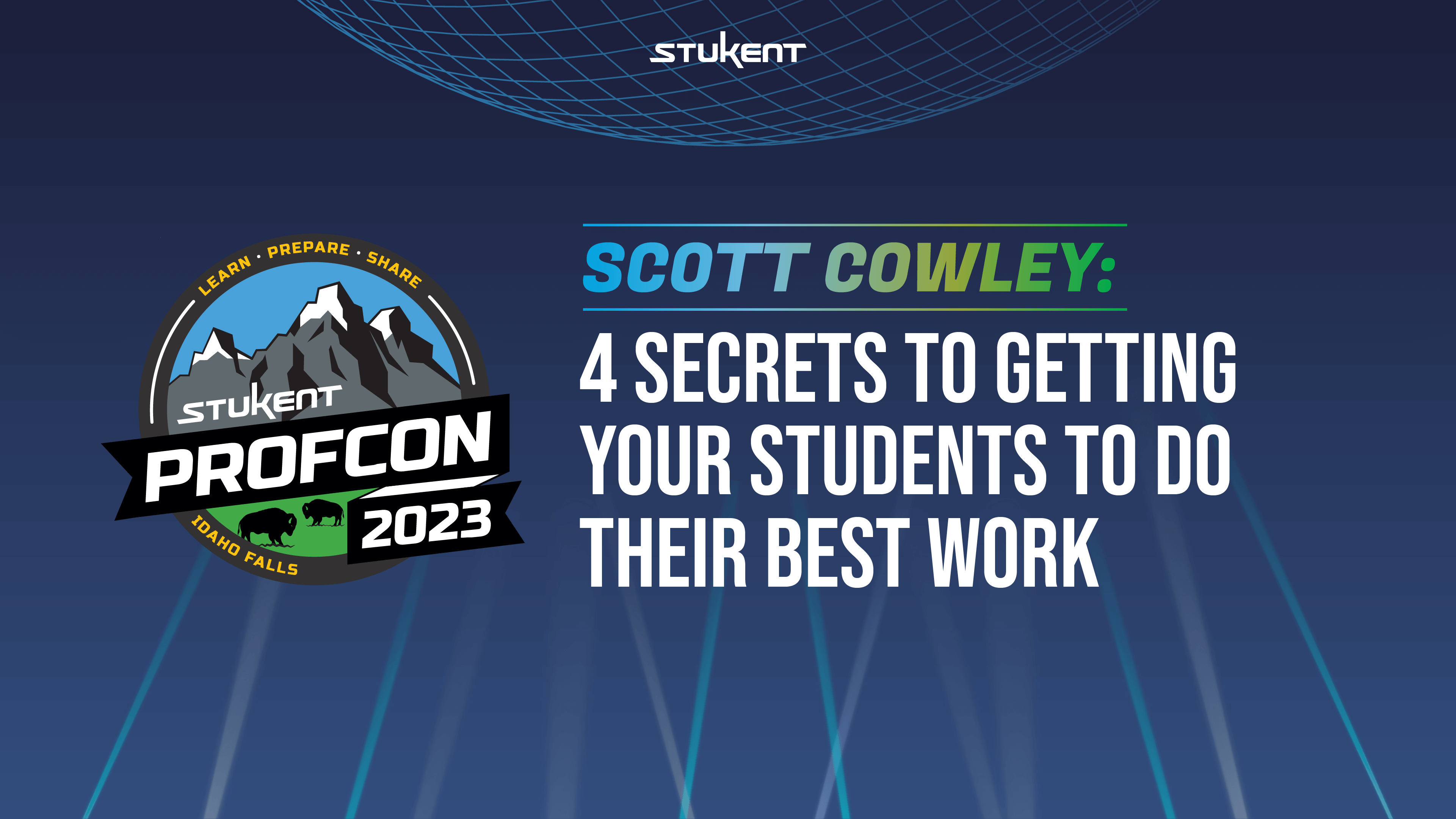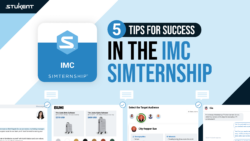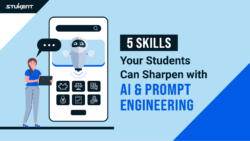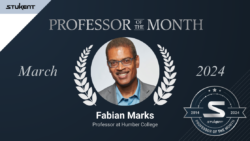How do you define your “best work”? Was it meaningful to you? Did you get public praise or receive an award for the work? Did you put your very best effort into the project?
Dr. Scott Cowley, an associate professor of marketing at Western Michigan University, believes that two components help us identify our best work: comparison and criteria. Scott shares his practices for fostering student success in his ProfCon 2023 session, “Secrets to Getting Students to Do Their Best Work.”
If you missed it, read on for the best tips from his session!
Create R.E.A.L. Projects
Scott introduces the acronym “R.E.A.L.” (Relevance, Entrepreneurship, Audience, and Leverage) as a framework to assess whether a project is worthy of becoming a student’s best work.
Relevance: Create projects relevant to the students’ interests and goals. For example, Scott teaches students search engine optimization (SEO) through creating YouTube videos, and some of these videos become their best work. One student created a video about using chopsticks to eat noodles, which gained 270,000 views after a couple years.
Entrepreneurship: Projects allow students to build something they can own and potentially derive value from in the future. Scott teaches students to build full-fledged WordPress websites, and one of his students used her website to sell social media services, eventually growing her business and employing three people.
Audience: Identify a target audience beyond just the professor. By giving students projects with real audiences, they can gain validation and feedback beyond the classroom setting. Scott uses client projects as examples, which provide students with authentic audiences to showcase their skills.
Leverage: Projects help students achieve professional goals. In Scott’s SEO and content strategy class, hands-on projects helped eight students land jobs related to their work.
The Skyscraper Approach
Scott’s most successful approach to encouraging students to create their best work is what he calls the “skyscraper” approach. In the context of student projects, the skyscraper approach involves showing students a high-quality project or example that already exists and then challenging them to surpass it by creating something even better.
“If you want students to create their best content, you’ve got to have a reference point for them to beat,” Scott said.
Scott provides five steps for the skyscraper approach:
1. Reference Point
The instructor presents an existing project, piece of content, or achievement considered exemplary. The reference point could be a successful YouTube video, a top-ranking blog post, a well-designed website, or any other relevant example.
2. Analyzing the Reference Point
Students analyze the reference point to understand why it is considered successful. They identify the strengths, weaknesses, and key elements of its effectiveness.
3. Determining Criteria for Improvement
Students should determine how to improve upon the reference point. They identify specific aspects they can enhance or add to improve their project.
4. Creating a Better Version
Armed with the analysis and criteria for improvement, students set out to create their own projects, striving to surpass the reference point by incorporating new ideas, depth, creativity, or higher quality.
5. Promoting the Project
Promote and recognize final projects. Scott suggests using platforms like Facebook groups, Reddit communities, or traditional forums to get the word out and reach a wider audience.
The skyscraper approach is effective because it challenges students to think critically, be creative, and strive for excellence. It provides them with a clear benchmark and pushes them to produce higher-quality projects.
Scott encourages regular feedback and revision cycles to support students in this process. It may take time for students to grasp what it means to create a better version, but with guidance, feedback, and practice, they can improve and excel in their projects.
The LIFT Model
There are no shortcuts when it comes to improving student work. It requires investing time in revision, seeking feedback, and making necessary changes based on that feedback. Scott illustrates this with an example from his wife’s experience as an author, where she spent 400 hours and went through nine revisions to create a successful book.
Despite the absence of shortcuts, instructors can shorten the time spent on projects and still ensure that students achieve their best work.
“If I can make my projects better semester after semester, I’m going to shorten the time it takes for students to get to their best work stage,” Scott said.
Scott uses the LIFT Model™ to guide and improve projects. The model is usually used as a conversion optimization framework applied for analyzing web and mobile experiences and defining A/B test hypotheses. Just like a combination of factors that enable a successful flight take-off, Scott’s model involves six principles, divided into three verbs: increase clarity and relevance, decrease anxiety and distractions, and elevate the value proposition and stakes.
1. Increase Clarity
Clarify the material or instructions provided to students before they begin their projects. Clear and well-defined guidelines and objectives help students understand what is expected of them, reducing confusion and uncertainty. Students who clearly understand the project’s requirements can produce high-quality work more effectively.
2. Increase Relevance
Make the project meaningful and applicable to students’ interests and goals. When projects align with students’ passions or career aspirations, they are more likely to be engaged and motivated to invest time and effort in producing their best work.
3. Decrease Anxiety
Reduce anxiety or stress associated with the project. Instructors can achieve this by providing a supportive and encouraging environment, offering guidance throughout the process, and clarifying students’ doubts or addressing concerns. When students feel supported, they can focus more on their creativity and critical thinking, leading to better outcomes (and less stress).
4. Decrease Distraction
Eliminate as many distractions as possible. Instructors can provide a focused and conducive learning environment, offer resources and tools that facilitate the project’s completion, and encourage time management strategies. Students can dedicate their attention and energy to producing their best work by reducing distractions.
5. Elevate Value Proposition
Demonstrate the value and importance of the project to students. Instructors can explain the real-world relevance of the project, how it aligns with their future goals, and the skills they will develop throughout the process. Students who see the project’s significance are more likely to fully invest themselves and strive for excellence. The principle can be described as the “vehicle of the plane.”
6. Elevate the Stakes
Increase the significance of the project’s outcome. By connecting the project to potential rewards, recognition, or opportunities, instructors can motivate students to perform at their best. Offering incentives, credit, or showcasing outstanding projects to a broader audience can elevate the stakes and encourage students to produce exceptional work. This is the “urgency” part of the model, which fuels the plane.
“I don’t know about you, but I’m not here trying to keep [students] from doing their best,” Scott said. “I want to be on their side. I want everyone to do as well as possible. I want to give them as many resources as possible to do that.”
By applying the LIFT Model, instructors can create a more supportive and conducive learning environment, optimize project quality, and motivate students to excel in their work. The model encourages a proactive approach to improving student projects by addressing various factors that contribute to their success.
Students will perform better on assignments if educators spend more time working to improve the project descriptions. Scott shares an example of an assignment where only 8% of students were successful the first year he assigned it. By the third year, he had made some project adjustments and saw a 75% success rate.
High Impact + Lower Effort Practices
Scott shares a few other secrets that require a lower effort but can be impactful for students. First, he encourages educators to share success stories.
“Keep a list of the best things that have happened to other students because of your projects,” Scott said. “Start collecting [success stories]. If you don’t have any stories, maybe it’s not the type of project that will create stories for you and you may want to think about changing your projects.”
When sharing work from previous students, Scott suggests sharing a variety of examples. This encourages students to think outside the box and pushes them to think creatively instead of copying one example.
Another practice Scott emphasizes is giving students feedback. He encourages providing input before, during, and after they create their project(s).
“I would say you’re going to create 100% better results by vetting their ideas in the right direction before they even start,” Scott said.
Educators should be positive in their feedback. Sitting side-by-side with your students during feedback will help them feel comfortable and show that you’re on their side. But how do you get students to do their best work without jeopardizing your relationship with them?
Scott answers this question with a quote from Dr. Adriane Grumbein, an educator from the University of Kentucky: “At the very beginning and during the process, I work hard to build rapport and get to know students and their lives. I tell them to separate their work from their personal worth.”
Scott wraps up his session by reminding educators that to have students do their best work, educators have to be at their best, too. Finding something that makes you happy and is therapeutic to you is important.
“I dare you to make your own classes the place where students do their best work,” Scott said. “I know you’re going to feel so much better about your life if you do.”
Marketing ProfCon 2023 was a three-day academic conference held from June 14 – 16, 2023. Each year, ProfCon presents actionable tips and strategies for marketing educators to use in their classrooms. To watch sessions on demand, visit the Stukent® Webinars Library.
Stukent is here to help educators help students help the world. To learn more about our first-in-the-world Simternships™ and courseware, or to get FREE instructor access to our products, visit our website.






